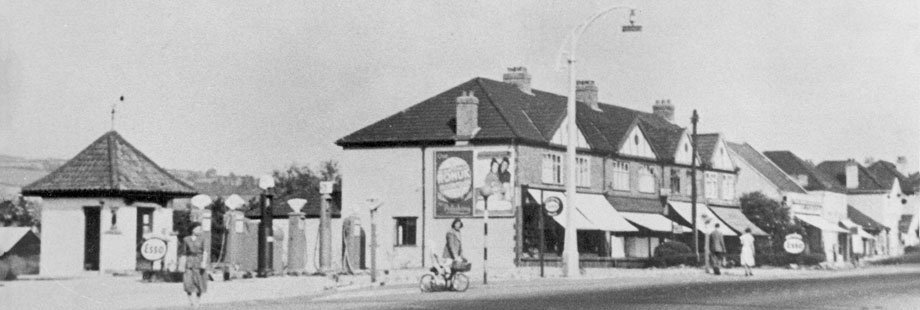Buildings & Roads
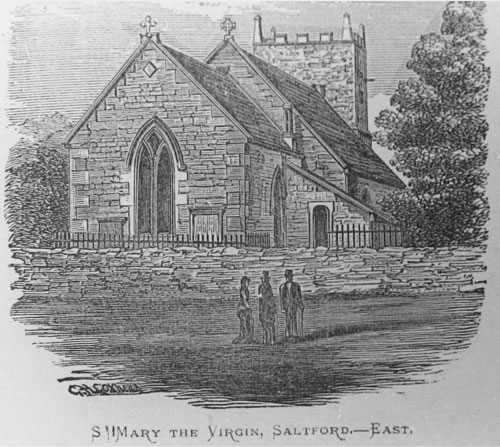
1900 sketch of St Mary's. More about St Mary's here.
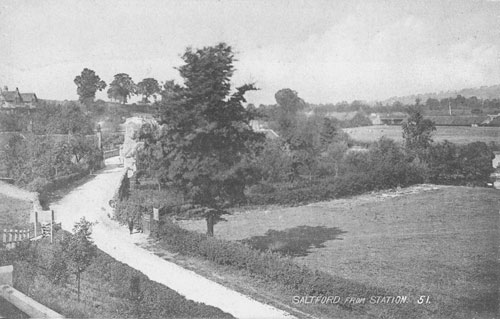
Saltford from Saltford railway station, 1900.
Click on photograph to open larger version in new window.
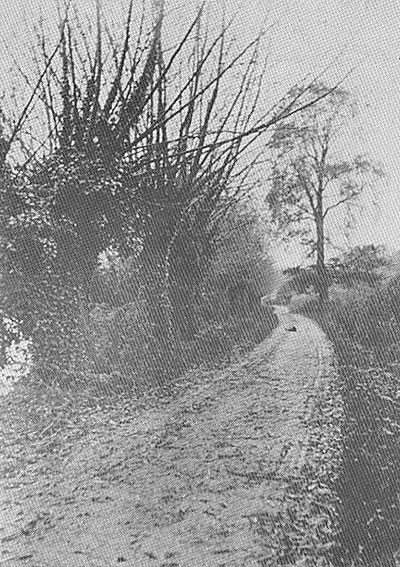
Mead Lane, 1900.
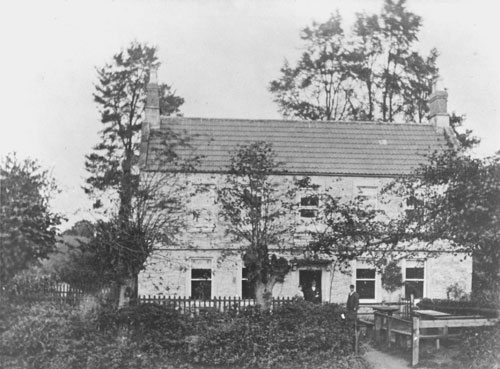
The Jolly Sailor Public House, by Saltford Lock, 1900.
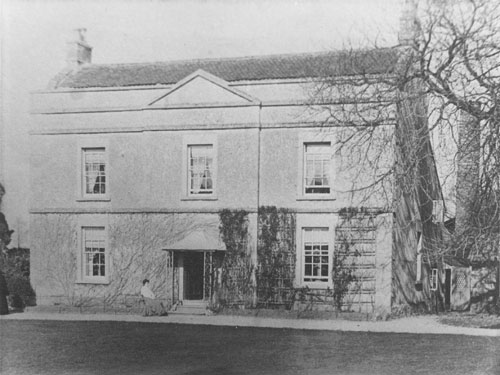
Wick House Farm, Saltford, 1900.
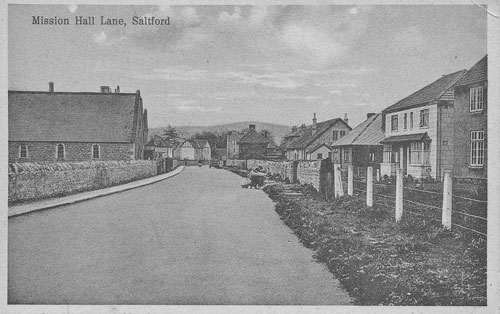
Mission Hall Lane (now Norman Road), Saltford, 1900s.
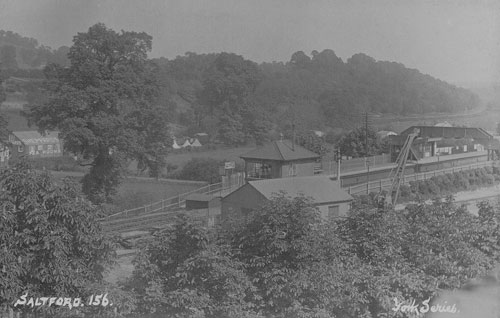
Saltford station, 1900s.
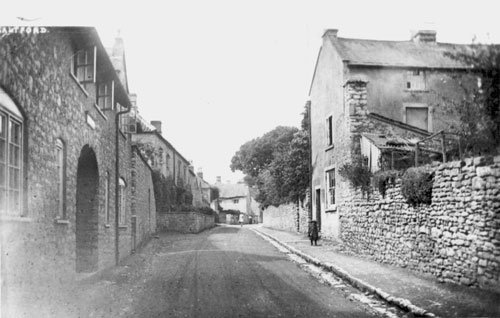
Rose Cottage (left) and Collins Buildings (right), High St. Saltford, 1900.
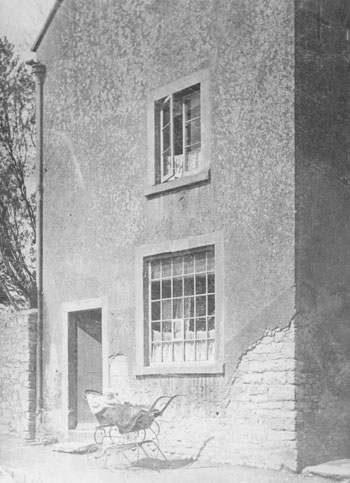
No. 1 Collins Buildings, High St. Saltford, 1900.
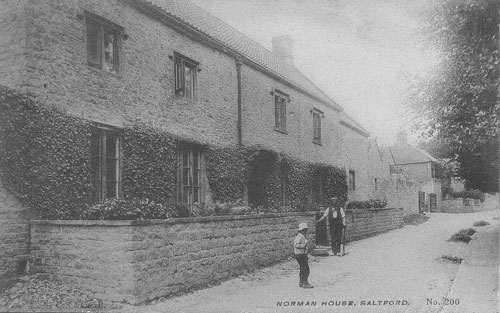
Norman House, High Street, Saltford, 1900s.
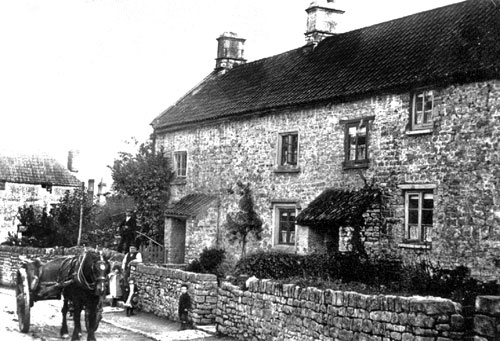
Doveton Cottages, High Street, early 1900s.
Built in 1600 these originally had a thatched roof and were renamed Lower, Middle and Upper Cottages. There was a well in the garden of Upper Cottage as was the case for many houses in the High Street. The Bird in Hand Public House can be seen behind (left).
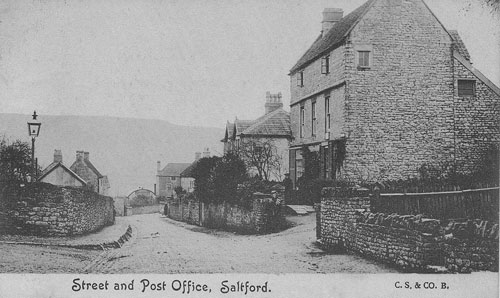
Pic. 1. High Street & Post Office (Brass Knocker), 1904
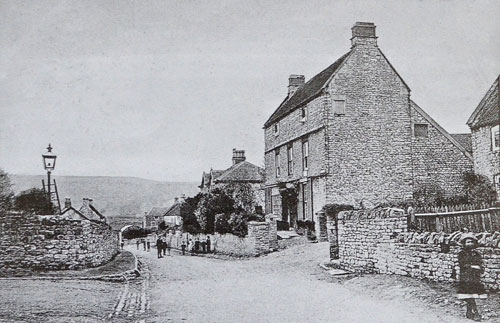
Pic. 2. High Street & Post Office (Brass Knocker), 1904
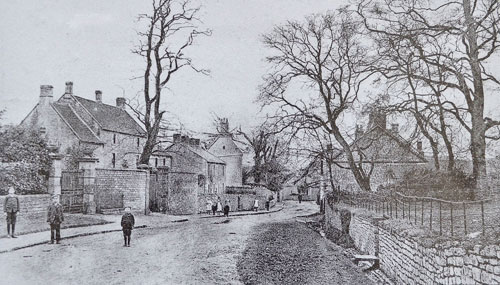
High Street, Saltford, 1904.

High Street, Saltford, early 1900s.
Shop window can be seen in centre of picture.
Courtesy of Keynsham and Saltford Local History Society.
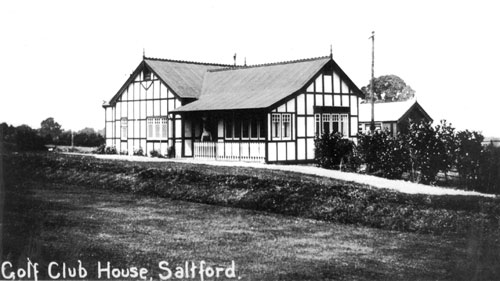
Saltford Golf Club House, c.1905
(the year after the golf club was established).
1904: Saltford Gold Club officially opened
The Bath Chronicle, October 27, 1904:-
"The best course in the district." This was the verdict passed by experts upon the course of the Saltford Golf Club, which was formally opened by Earl Temple, the president, on Saturday. A better day for the opening ceremony could not have been wished for, and a large company of ladies and gentlemen responded to the invitation to be present, and
followed with keen interest the match between White and Pople, which followed immediately upon the opening drive of his lordship. Everything promises well for the new venture, and already the limit of the number of members - 100 gentlemen and 25 ladies - has nearly been reached, very few vacancies remaining to be filled. The officers of the club are:- President, Earl Temple; hon. secretary, H. S. Radcliffe; hon. Treasurer, Joseph
Rogers; chairman of committee, Gerald Mosely; committee, A. Symes, Albert Ford, F. Forster, T. Allison, P. Smith, H. J. Andrews, P. Champion, W. J. Cook, H. Wetherman, L. S. McKensie, B. H. Matthews, Frank Whittuck, and A. H. Hobbs.
~
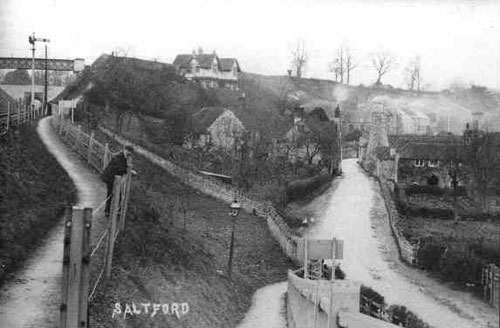
Saltford and the Brass Mill, c.1905.
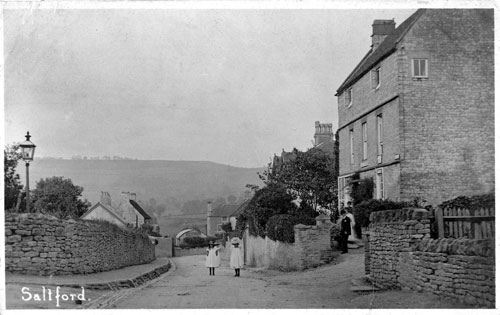
The Brass Knocker (Post Office), High Street, Saltford, c.1908.
Note 1. In the 1930s the village telephone exchange was situated inside the Brass Knocker (on the left after entering the front door). The lady who operated the exchange knew all the village gossip as she could listen in on telephone calls at that time.
Note 2. The white building (Mr Lavington's hut) on the left of the postcard above was the Headquarters for Saltford Boy Scouts from 1946 until 1960. It was also known as the "Village Reading Room" and "Iron Building" when in 1911 it became the HQ and Club House for the Saltford & District Conservative & Unionist Association.
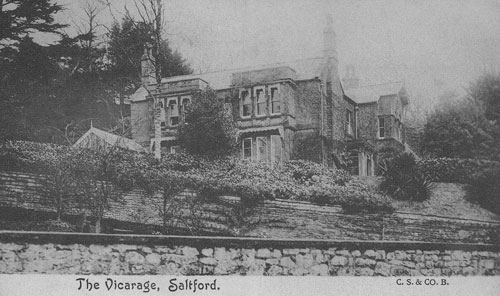
'The Vicarage' or 'The Rectory', Saltford c.1907.
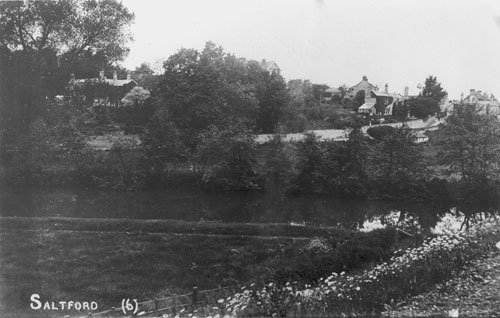
The Rectory, Bird in Hand etc. from the
Kelston side of the river, c.1908.
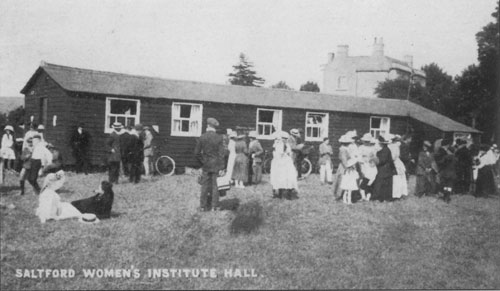
The Women's Institute Hall/Hut, Norman Road, early 1920s.
The Saltford Women's Institute hut was a former army hut acquired from Codford, Wiltshire and erected by G H Sims and his son Percy Sims. It was erected in an avenue of trees which were removed when Norman Road, originally Boyd Lane, was widened to cope with an increase in traffic arising from new housing.
The hut was opened by Colonel Rolleston of Saltford House on whose land the hut was erected. The hut was subsequently demolished to make way for more houses.
Acknowledgements/Information Sources
'A History of Saltford Village' by Percy Sims (1976)
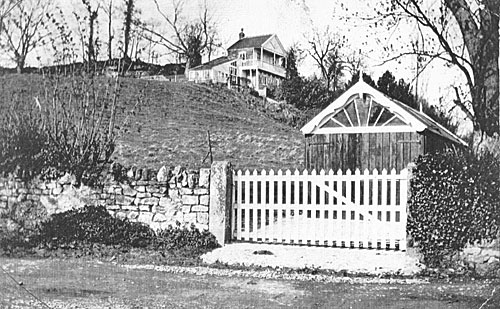
Spion Kop, 1920s.
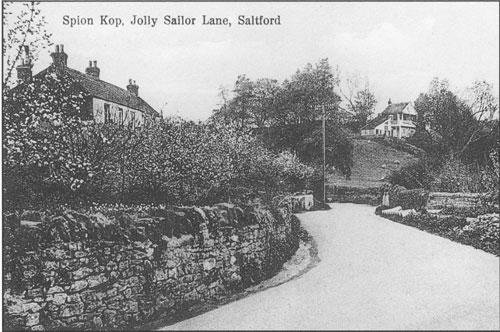
c.1925: Spion Kop and Mead Lane, Saltford.
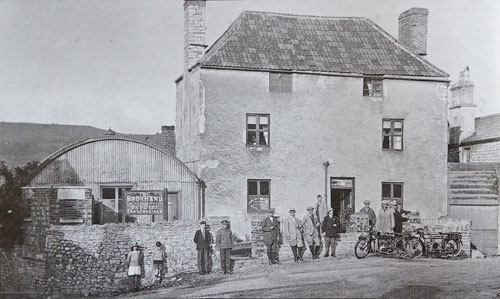
1925: Bird in Hand, High Street, Saltford.
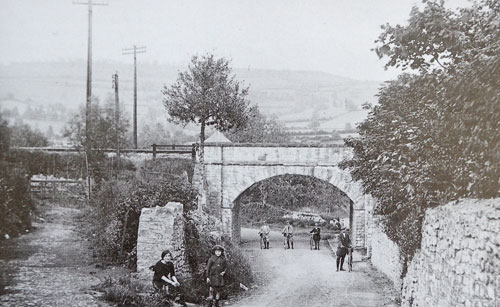
1925: High Street meets Mead Lane, Saltford.
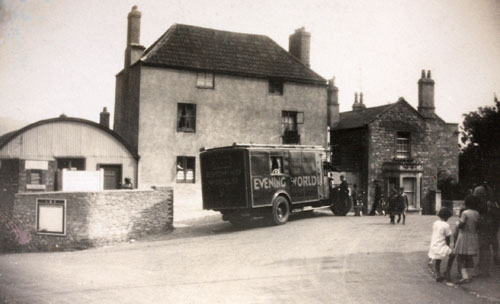
Bird in Hand, High Street, Saltford, in the (est.) late 1920s.
The LH annex with the curved roof was the Tea Rooms.
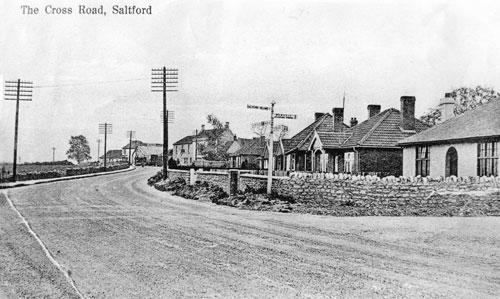
The Cross Roads, Saltford, est. 1920s.
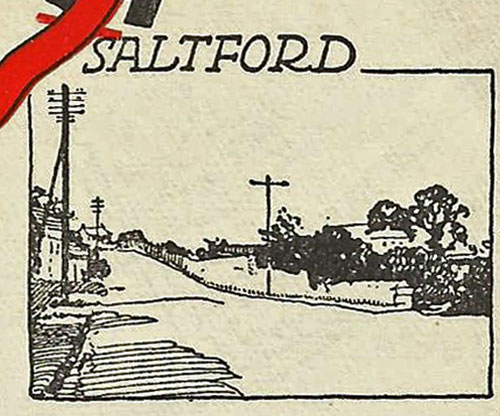
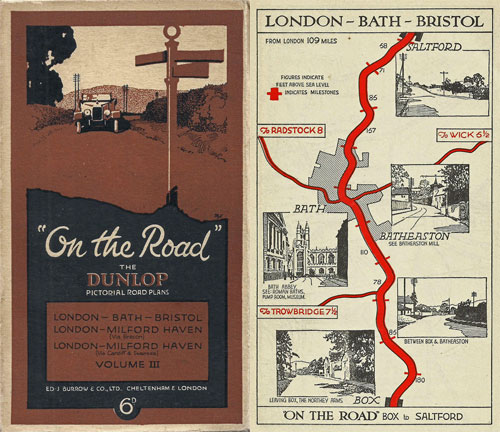
The Dunlop "On the Road" series of pictorial road maps published by EDJ Burrow & Co. Ltd includes this artist's sketch impression of the A4 through Saltford c.1926. Images kindly provided by the Museum of Bath at Work, 2020.
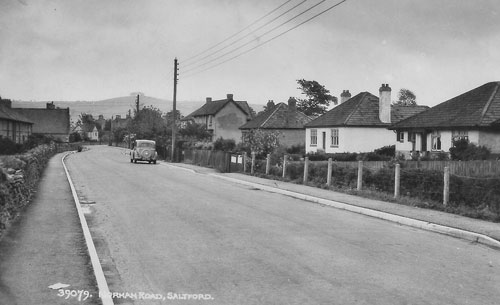
1930: Norman Road, Saltford.
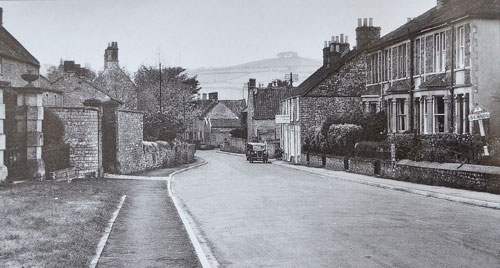
1930s: High Street, Saltford.

14th April 1932: A4 Road Saltford - Looking east.
The LH bungalow is on the corner of what became Lansdown Rd.
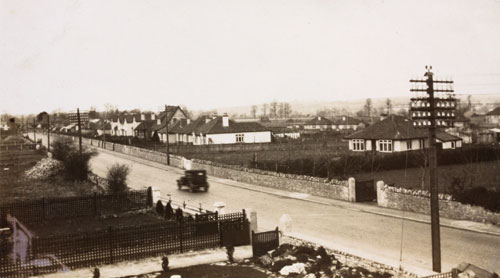
14th April 1932: A4 Road Saltford - Looking west
1938 Construction of Claverton Road
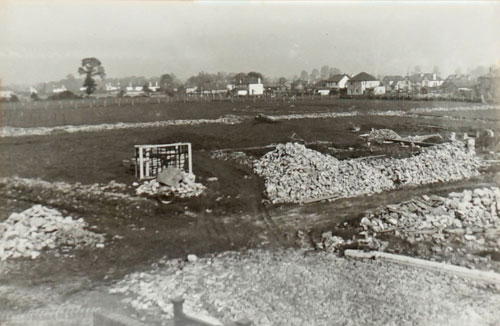
Photograph copied in 2015 courtesy of Derek Cann.
1938 view north from front of 5 Claverton Road towards the A4 road. Justice Avenue was built on the field in the foreground.
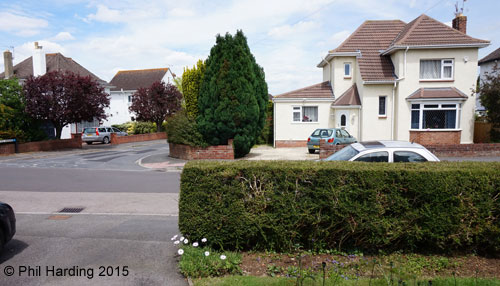
The same view (approx.) from 5 Claverton Road in June 2015.
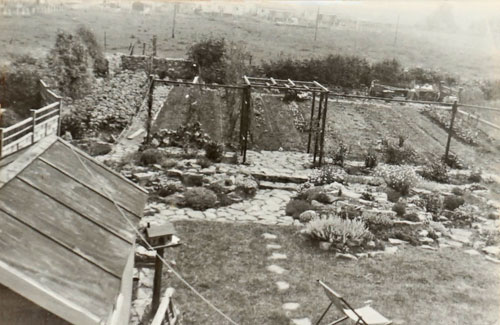
Photograph copied in 2015 courtesy of Derek Cann.
1938 view south from rear of 5 Claverton Road towards Manor Road. Saltford School was subsequently built on the field shown (right).
1943 or 1944: High Street Grocery Store
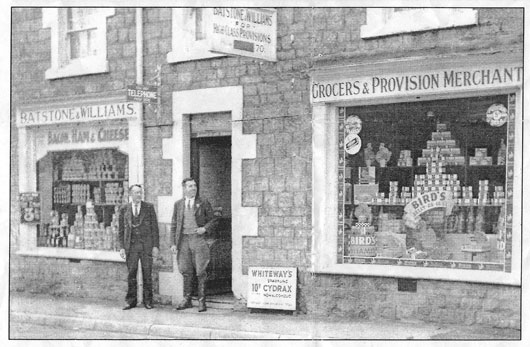
Messrs Batstone & Williams outside their grocery store, 14 High St (then 2 Walnut Cottages), c.1943 or 1944
This photograph appeared in the 11th March 1995 edition of the Bath Chronicle as part of a "Down Memory Lane" series of old photographs. It had been supplied by Ernest Williams from Bath who ran the grocery store "Batstone & Williams" in the High Street at No. 14* (now a private dwelling) with Mr Batstone from 1939 to 1944. The masking of the telephone number on the hanging shop sign was a wartime security measure.
When Colonel Rolleston lived at Saltford House from 1898 to 1921 he purchased his tobacco which he shared with local men and sweets for local children at this store when it was ran by Jimmy Williams (possibly a relative of Ernest Williams) - see more about Col. Rolleston here.
*The three cottages of which No. 14 was the middle cottage, are thought to have been built in the early 19th Century and were at one time named "Walnut Cottages"; the store was No. 2 Walnut Cottages and Mr Arthur Batstone was listed as living there in the Post Office Bath Directory for Saltford of 1937 whilst Mr J (Jimmy) Williams is listed in the 1896 Directory (these can be seen in our Document Library).
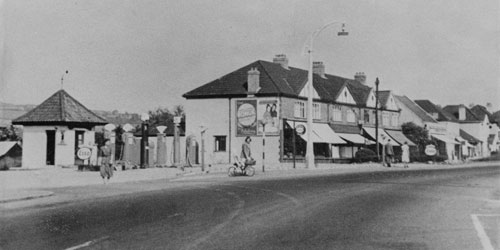
1950
Mr Pole's (subsequently Thomas's) Filling Station and Shops. The location (where Beech Rd meets the A4 Bath Rd) was then known locally as 'Pole's Corner'. In front of the petrol pumps was a paved
area of crazy paving with a small fish pond in the centre. See below for the same view in 2017. We also have a 1961 photograph of Saltford Motors when cars were first displayed on the roof canopy in our 20th Century Transport section.

Saltford Motors in 2017.
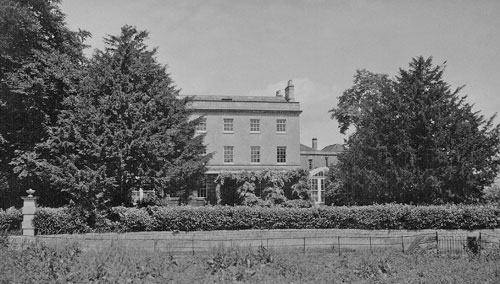
Saltford House from field in Beech Road (early 1950s)
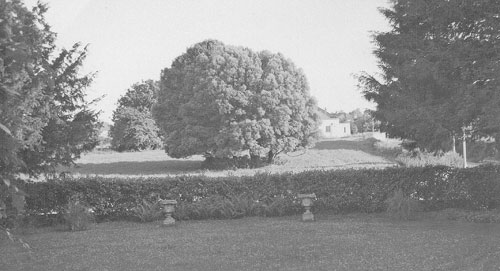
Beech Rd, field & High St from Saltford House, early 1950s.
Telephone Exchange is 1st building on LH side of Beech Rd.
Below is the same view in 2016.
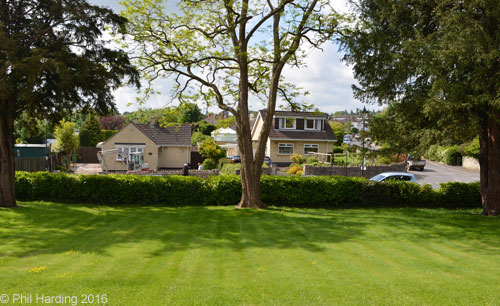
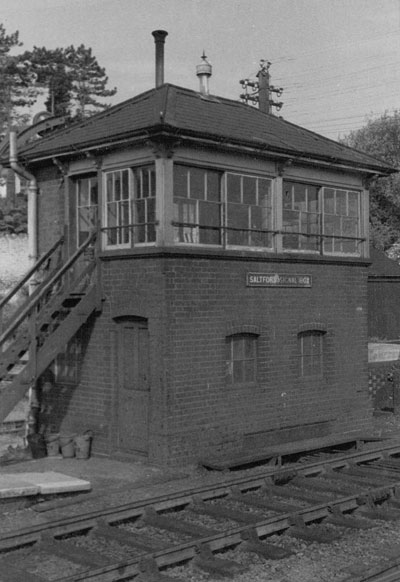
Saltford Signal box (located at the station) in 1958.
Photograph kindly provided by Stella Hurley.
© Saltford Environment Group
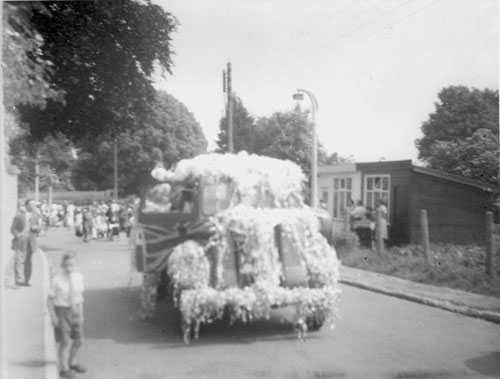
April 1960: Street Carnival - Junction of Beech and Norman Roads.
Note: The two shed-like buildings are on the location currently
occupied by the war memorial. The RH (darker) hut was the cobblers and the LH hut was the butchers.
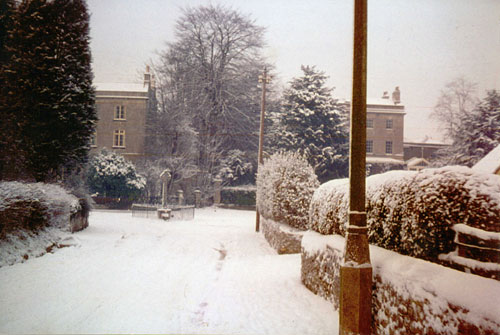
Winter of 1962-63:
Top of High Street, Tunnel House (left) and
Saltford House (right) viewed looking down Beech Road.
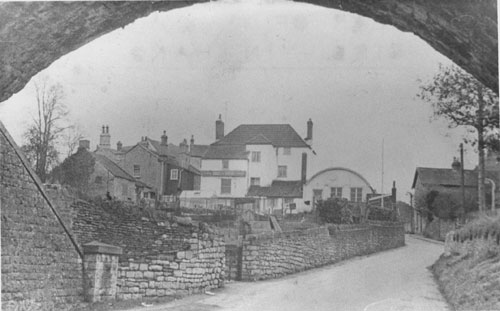
1970: Bird in Hand (from rear).
Longreach House (1970s)
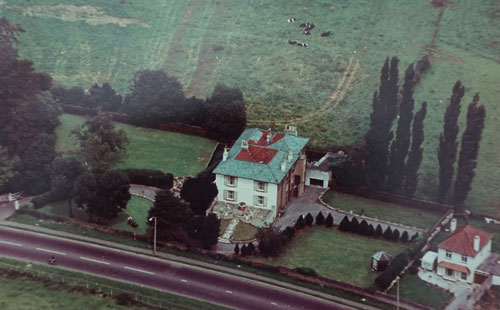
Longreach House, Bath Road (just within Saltford's parish boundary)
Miss Gwendolyn Wills of the famous tobacco family lived at Longreach House in the 1920s and 30s. Her chauffeur was William Thomas Baker of Saltford (father of John Baker) and he drove her around in a Wolseley 12-48 Series III.
This was also the home at one time of Horace Batchelor (1898 - 1977) the notable advertiser on Radio Luxembourg during the late 1940s to early 1960s.
Horace Bathchelor advertised a way to win money by predicting the results of football matches, sponsoring programmes on Radio Luxembourg. His spelling out of Keynsham, K-E-Y-N-S-H-A-M, from where he operated, certainly put Keynsham on the map.
Apparently the missing green paint on the roof was a scam by the builder who charged Horace for painting the whole roof but as it would not be noticed he left the central section that is out of view from street level...
After his death, the house was converted to a nursing home, then a hotel and has since been replaced by a small and well proportioned block of flats.
Acknowledgements/Information Sources
Longreach House photograph kindly supplied by Jill Coles, former owner of Longreach House.
Saltford House and the old buildings behind (1980/81)
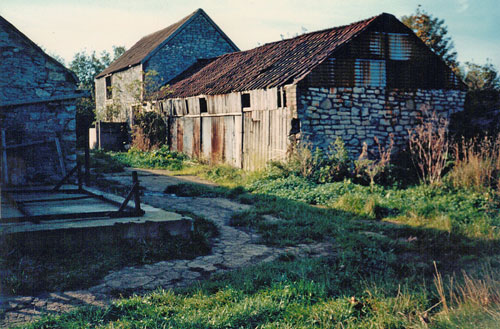
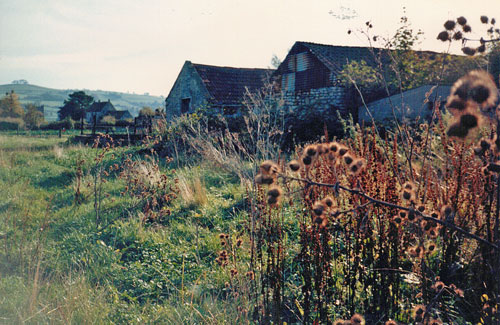
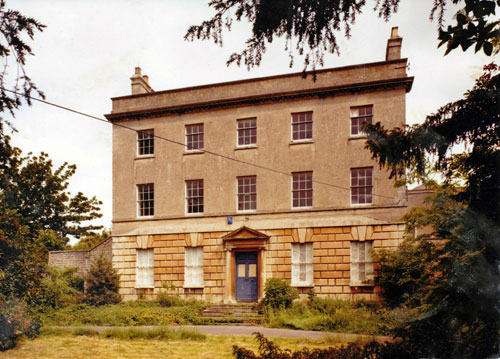
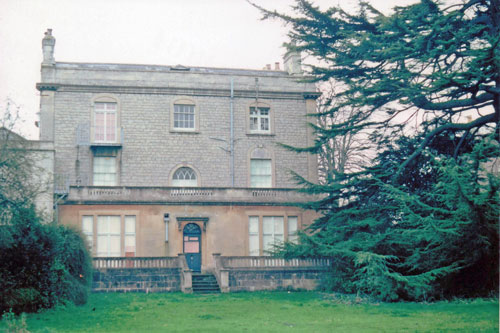
In these photographs you can see the old dilapidated buildings behind Saltford House House (c.1980 by Malcolm Guthrie) and the front and rear of Saltford House in 1981. Saltford House was then in a state of disrepair after being left unoccupied and squatters had been evicted.
Saltford House was purchased in 1981 by Ivor Ford and thereafter he restored this fine Georgian late-Palladian style house to its former glory.
Acknowledgements/Information Sources
Old building photographs provided by Malcolm Guthrie.
Saltford House photographs provided by Ivor Ford.
Return to top of page
Transport
The Land Slip at Saltford, 1st March 1900
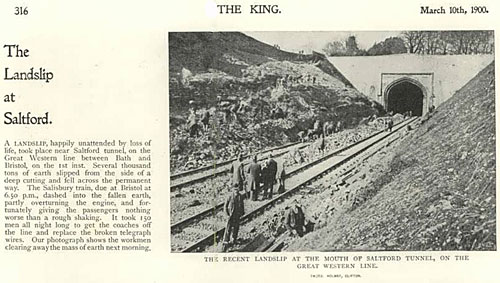
The text on this press article reads:-
A LANDSLIP, happily unattended by loss of life, took place by Saltford tunnel, on the Great Western line between Bath and Bristol, on the 1st inst. Several thousand tons of earth slipped from the side of a deep cutting and fell across the permanent way. The Salisbury train, due at Bristol at 6.50 p.m., dashed into the fallen earth, partly overturning the engine, and
fortunately giving the passengers nothing worse than a rough shaking. It took 150 men all night long to get the coaches off the line and replace the broken telegraph wires. Our photograph shows the workmen clearing away the mass of earth next morning.
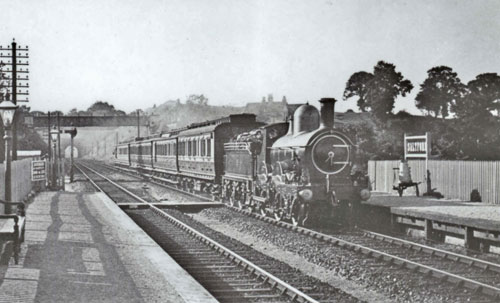
GWR Class 3232 steam locomotive (built 1892/3 in Swindon)
from Bristol arriving at Saltford station c.1900-05.
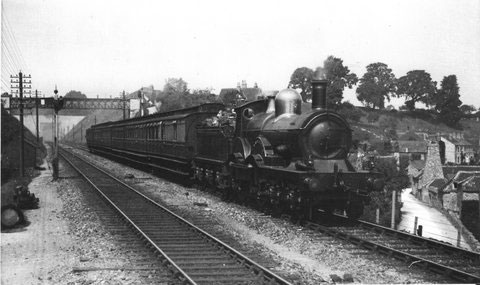
GWR 7 (Armstrong) Class steam locomotive approaching Saltford station c.1900.
You can see Saltford Tunnel on LH side and the Brass Mill on the right.
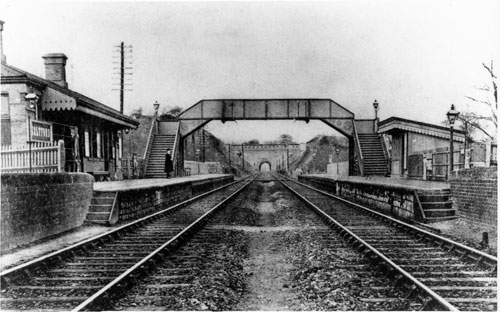
Saltford station c.1901.
The other station at Saltford
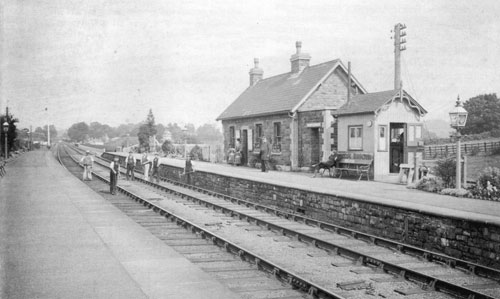
'Kelston for Saltford' station on the Midland Railway line, early 1900s.
The view of the station is of the line towards Mangotsfield, Bristol.
This station on the Midland (later LMS) line was opened on land owned by Col. Inigo Jones of Kelston Park on 1st December 1869. Unusually there was no road access for this station. The summer timetable for 1903 showed that as many as 11 weekday trains served the station in each direction but only 3 stopped on Sundays.
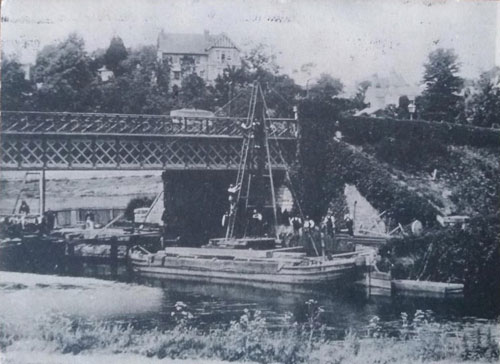
This postcard from c.1905 shows maintenance work underway on the Midland line (later LMS) bridge at Saltford near The Shallows.
The 1906 Bristol Touring car of Colonel Rolleston
(Registration plate AE 1061)
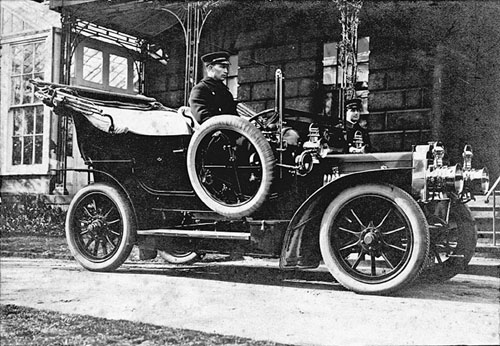
The 1906 Bristol Touring Car, registration plate AE 1061, owned by Colonel Rolleston photographed when the car was brand new with the Colonel's chauffeur, Frederick William King, sitting at the wheel. Information about the Colonel himself can be found on page 3.
Frederick King worked for the Rolleston family before World War I, then the Flying Corps in France before returning to Saltford House where he remained until the Colonel's death in 1921. Thereafter he drove delivery lorries for Avon Paint Works.
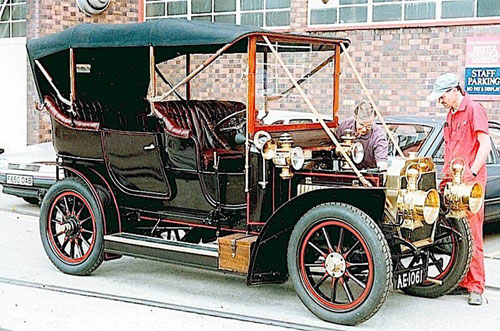
The fully restored 1906 Bristol Touring Car once owned by Colonel Rolleston, the car's first owner from new. It was driven by his chauffeur, Frederick William King, and was one of the the first privately owned cars in Saltford.
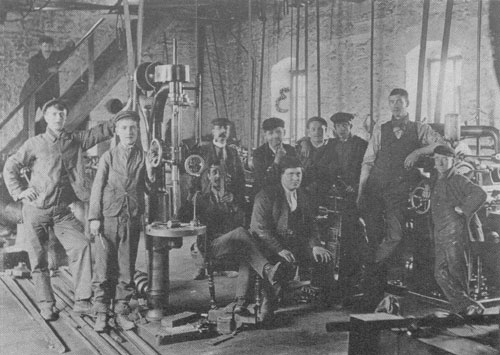
Pictured above (c.1906) are some of the workforce in the workshop of the Bristol Motor Company. These are almost certainly the same men that produced AE 1061.
Technical data (courtesy of the Bristol Motor Company Ltd)
18 of this model with the 16-20 h.p. 4-cyclinder engine were built between 1905 and 1907. AE 1061 was the 4th of 24 of these models built and is the only known surviving model. It replaced the under-powered 2-cylinder 10 h.p. model that appeared in 1902 (after just 6 of the 1902 model had been built).
The engine was based on an aluminium crankcase fitted with two pairs of cast-iron cylinders. The cylinders had steel liners, and the Bristol Motor Company was said to have been the first manufacturer to adopt this practice.
Each cylinder had a pair of spark-plugs, for coil or magneto ignition. All the castings for the engine were made at the works, with the exception of the cylinders, which were made by Bryants of Bread Street, Bristol.
The power was transmitted through a leather-lined cone clutch and three-speed gearbox. Gear-changing was at first a hit-and-miss affair, because a steering column selector was used. This was later replaced by a standard floor-mounted lever with a notched quadrant.
Band brakes operated on the drive-shaft from the footbrake, and on the rear wheels from the handbrake.
Additionally, a pawl and ratchet was fitted to the drive shaft to stop the car running back on a hill. Bristol Tourers were built on a long or short wheelbase chassis made of solid ash reinforced with steel plates. The bodies were built to the requirements of the customer, either by Perry & Turner of Stokes Croft, Bristol, or other local
coachbuilders. Some, such as AE 1061, were fitted with hooded open bodies, and others with saloon bodies.
Ownership of AE 1061 after Colonel Rolleston
After the Colonel's death in 1921 the car was sold to an unknown person, believed to be in Barnstaple. It was later purchased by Keetch & Turner, Engineers of East Street, Bedminster, and brought back to Bristol for an overhaul and sale. As the car was no longer fashionable for use as a private car, the back seat was then removed to convert the vehicle to a pick-up truck by Keetch & Turner; it was sold to a farmer near Nailsea.
In 1934 the Bristol Motor company re-discovered the car at the farm in Nailsea, its back wheels jacked up to take a belt drive to drive a saw bench. After a few years of display at showrooms in Victoria Street, Bristol, it was presented to the Bristol City Museum in 1937. Although slightly damaged during the bombing of Bristol during WWII in 1978 restoration of the car by Mr F J Lester commenced.
Acknowledgements/Information Sources
1906 photograph of Col Rolleston's car & related information from City of Bristol Museum & Art gallery undated leaflet. Original photograph owned by Fred King's son Stanley King (from Salisbury).
Colour photograph of Col Rolleston's car courtesy of Bristol Museums Galleries & Archives.
~
Saltford's first motor bus service at The Crown Inn, 1906
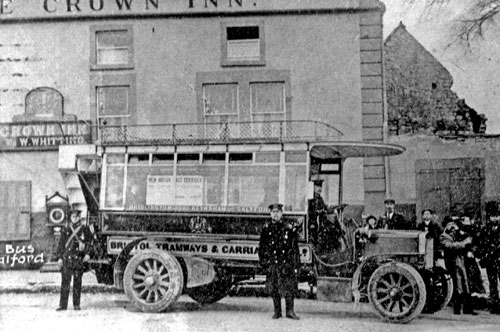
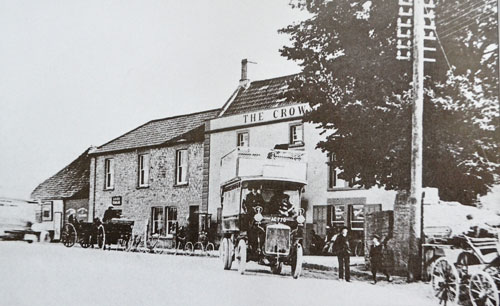
The Crown Inn, 6th February 1906,
and Saltford's first motor bus service.
The Avon Tri-mobile and Saltford's contribution to motoring and the history of the postal service
The Crown Inn and Avon Tri-mobile c.1906
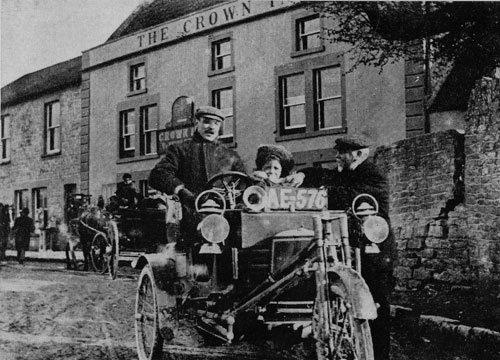
Photograph kindly provided by Carl Say.
The car in this evocative photograph of The Crown Inn in Saltford is an Avon Tri-mobile built by the Avon Motor Manufacturing Co. Ltd of Keynsham. They were in business from 1903 to 1912, latterly with four wheeled cars.
Avon Motor Manufacturing Co. was owned by George Alexander Henshaw, Chartered Engineer, co-founder in 1879 of the engineering company Strachan & Henshaw of Bristol. George Henshaw lived in Saltford at the bottom of Saltford Hill. The Avon Motor Manufacturing Co. made these vehicles on the Keynsham/Saltford border.
The Tri-mobile was powered by Avon Motor Manufacturing Co. Ltd's own single cylinder water cooled engine with sizes ranging from 4, 4.5, 5 and to 6 hp. The vehicle's engine was rear mounted (with front radiator) and had a three speed gearbox and chain driven final drive.
Their London agents were the Otto-Bennett Motor Co in Snow Hill, but most sales were local to the Bristol area. Prices ranged from 60 to 95 guineas (the 4-wheeled version was 106 guineas - see sales leaflet below which you can download).
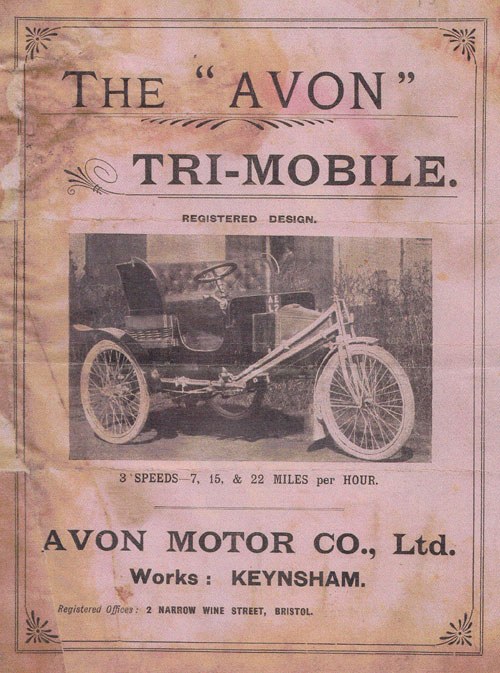
Sales leaflet, c.1905, for the Avon Tri-mobile made in Keynsham.
Click on image or here to open:
Tri-Mobile Sales Leaflet from
Avon Motor Manufacturing c.1905
(pdf 1.66MB opens in new window)
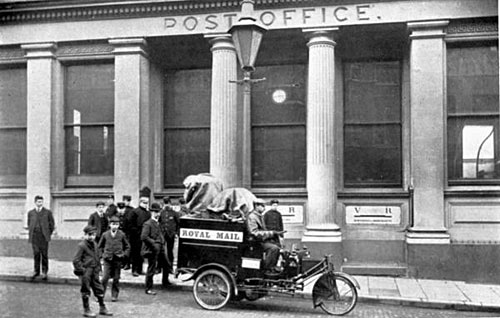
Pictured above in c.1905, the Avon Tri-mobile, built to a Bristol Post Office design, and constructed by the Avon Motor Manufacturing Company in Keynsham, was the first motor vehicle powered by an internal combustion engine used by the Post Office in Bristol to transport His Majesty King Edward VII's Royal Mail by road.
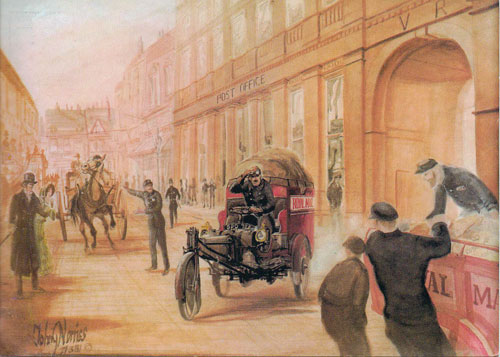
The Bristol P.O. Avon Mercury Tri-mobile c.1905.
(1987 Royal Mail Post Card painted by John G Norris, 1981).
The above is one of a set of four postcards featuring mail carriers built in Bristol from 1830. These were (i) an 1830 mail coach pulled by four horses, (ii) SS Great Britain of 1845, (iii) Avon Mercury Tri-mobile c.1905, and (iv) Concorde 1980.
The back of the postcard states: "The Avon Tri-mobile, built in Keynsham, leaves Small Street Post Office loaded with mail circa 1905."
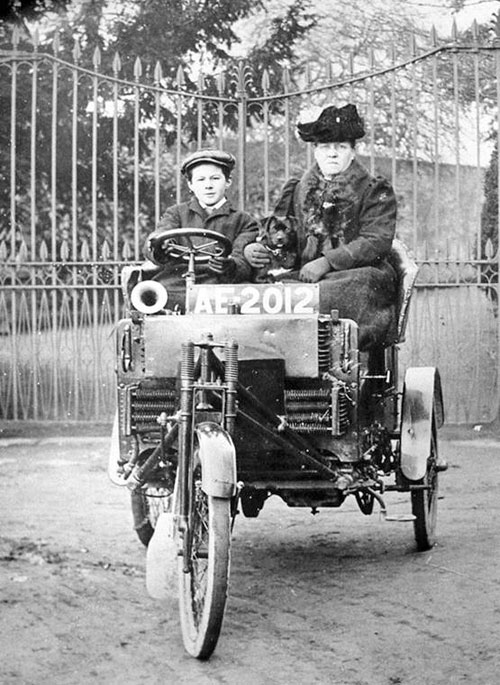
Avon Tri-mobile driven by A E Crannock, 1911.
Courtesy of Keynsham & Saltford Local History Society.
Mr A E Cannock (aged 14) is pictured here at the wheel of an Avon Tri-mobile. Sitting beside him is his aunt Miss E Cox (plus dog!). As the Tri-mobile was classed as a motorcycle Mr Cannock was able to own and drive this vehicle at such a young age in 1911. Mr Cannock started a motor vehicle garage in Keynsham in 1919.
Acknowledgement/Information Sources:
Avon Tri-mobile sales leaflet and technical history - Michael Worthington-Williams, Motoring Historian and Journalist, Carmarthenshire (2016)
The King's Post by R C Tombs, I.S.O. (1905)
Keynsham and Saltford Life and Work in Times Past 1539-1945 - Keynsham and Saltford Local History Society (1990)
Brian Vowles, Keynsham and Saltford Local History Society (2016)
~
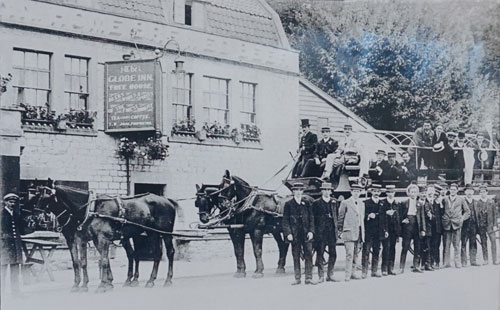
The Globe Inn, Newton St Loe 1910.
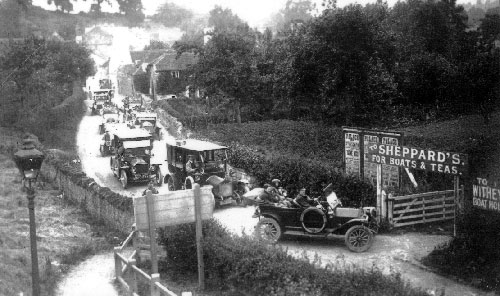
Car rally participants arriving for tea at Sheppard's, 1910
Acknowledgement/Information Source: Tony Coverdale.
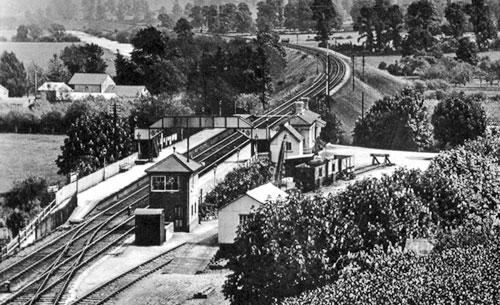
Saltford Station c.1920.
(Reproduced with kind permission of Akeman Press, Bath).
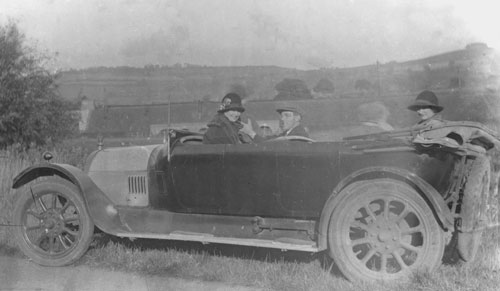
An Angus Sanderson motor car, built in Birtley, Co Durham
parked at The Shallows, Saltford, 1920.
About 3,000 Angus Sanderson motor cars were built between 1918 and 1927. The Angus Sanderson had a 14.3 hp four cylinder side-valve engine made by Tylors, a firm which dated back to the late 1700s as iron founders and who were well known in Victorian times for their lavatory cisterns. They also supplied engines to the Associated Equipment Co (AEC) who built London's buses. They were also famous for casting the bronze wheels for the gun carriage used to carry the Duke of Wellington's coffin in 1852.
Information source:
Michael Worthington-Williams, Motoring Historian & Journalist (2016)
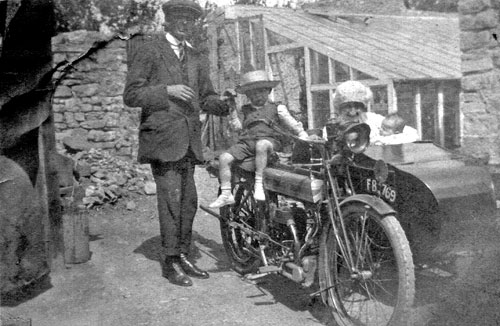
William Trimby and family with Triumph motorcycle and sidecar, 1920.
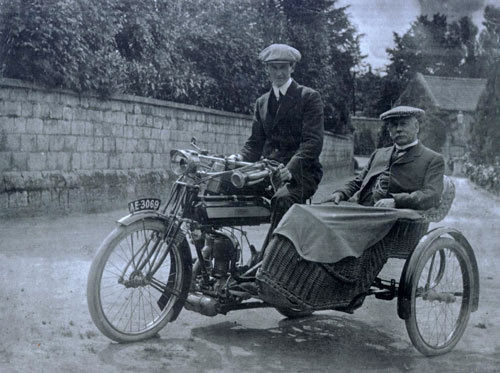
Pictured here in 1925 is the last owner of Saltford Brass Mill, Alfred Thomas Davies (in sidecar), with his son Alfred Cecil Vian Davies (on motorbike). The photograph is taken outside Avon House in Keynsham and the motorbike is a 1914 Humber 500cc 3-speed.
Acknowledgements/Information Sources
Photograph and information from Tony Coverdale of the Saltford Brass Mill Project (2016).
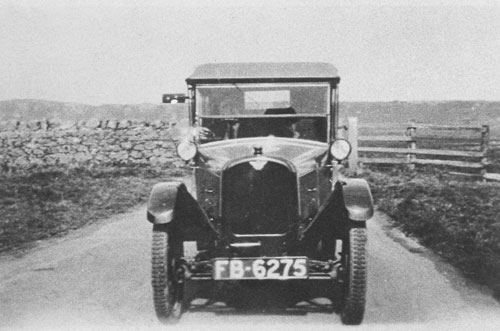
A 1928 Bath registered Austin Seven motor car.
Information source:
Michael Worthington-Williams, Motoring Historian & Journalist (2016)
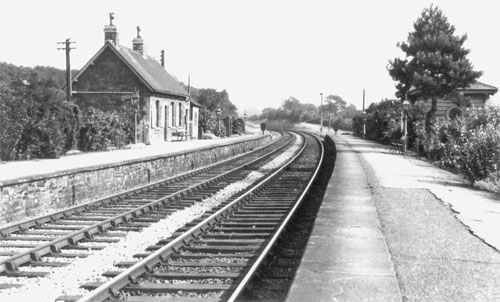
1930s Kelston Station, known as "Kelston for Saltford".
1905 - 1938 Tram Service at Newton St Loe
1906 Keynsham D.C. opposes tramway extension to Saltford
The Bath Chronicle, January 18, 1906:-
At their meeting on Tuesday, the Keynsham District Council decided to oppose the proposed extension of the Bath electric tramways from Newton St. Loe to Saltford. Col. Rolleston said that as far as he had ascertained they did not want the tramways at all. Landowners did not want
them; people said that on Sundays they would have people in Saltford trespassing all over the place; and he did not think the people would be of the kind the hotel-keeper would desire. The Clerk said it was merely a question of the Keynsham Council giving the County Council their moral support.
~
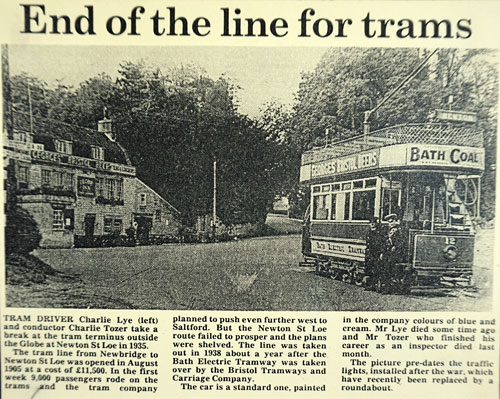
1935 The Globe Inn and Tram Terminus from post WWII newspaper article (undated).
End of the line for trams
The text in the above article reads as follows:
TRAM DRIVER Charlie Lye (left) and conductor Charlie Tozer take a break at the tram terminus outside the Globe at Newton St Loe in 1935.
The tram line from Newbridge to Newton St. Loe was opened in August 1905 at a cost of £11,500. In the first week 9,000 passengers rode on the trams and the tram company planned to push even further west to Saltford. But the Newton St Loe route failed to prosper and the plans were shelved. The line was taken out in 1938 about a year after the Bath Electric Tramway was taken over by the Bristol Carriage Company.
The car is a standard one, painted in the company colours of blue and cream. My Lye died some time ago and Mr Tozer who finished his career as an inspector died last month.
The picture pre-dates the traffic lights, installed after the war, which have recently been replaced by a roundabout.
~
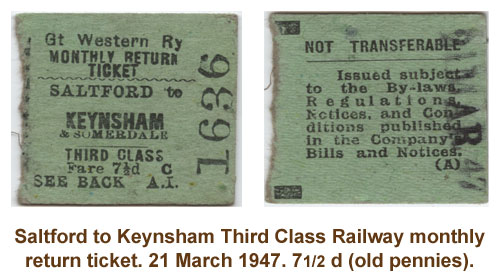
1947 "seven pence hapenny" 3rd class railway return ticket, Saltford to Keynsham.
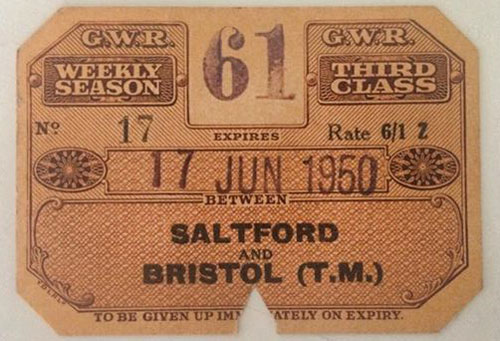
1950 3rd class railway weekly season ticket, Saltford to Bristol Temple Meads.
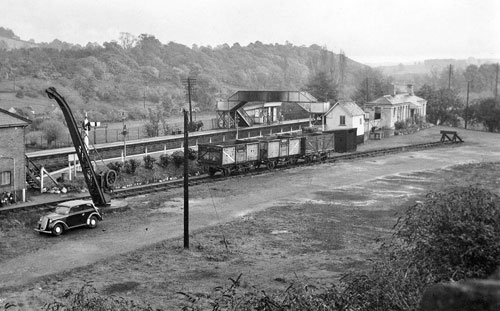
Saltford Station in 1958.
The car (an Opel) belonged to signalman Dave Boston.
Photograph kindly provided by Dave Boston.
© Saltford Environment Group
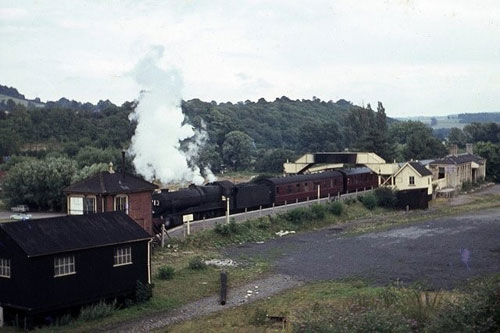
Saltford Station, 1962, with British Railways Steam Locomotive 1024.
Photograph posted on Flickr by Paul Townsend, 4.1.2015.
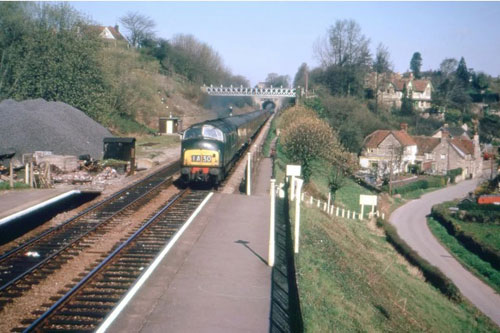
Saltford Station, 1960s. Signal box already removed.
Return to top of page
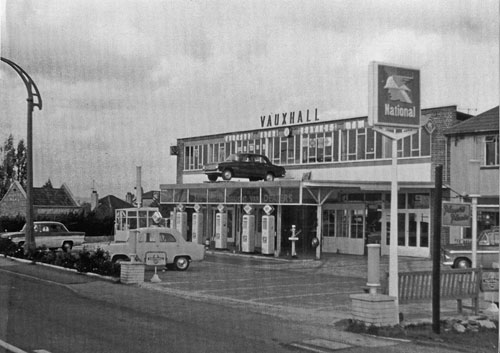
Saltford Motors, Oct 1961: First car display on canopy.
Courtesy of Keynsham and Saltford Local History Society.
1972: Saltford bypass proposed route causes anger
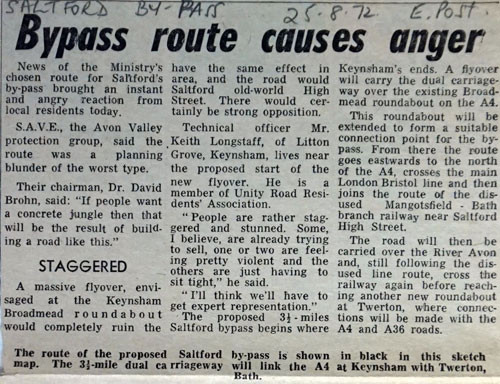
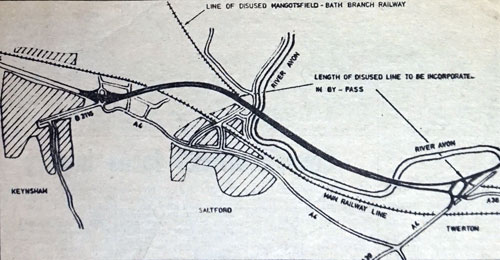
The above article from the Bristol Evening Post (25 August 1972) was published two years after Saltford railway station was closed and before the new housing development on the south side of the A4 in Saltford had been constructed. It shows that even then, proposals for a road bypass were proving controversial.
The plans came to nothing and in 1986 the former Midland Railway Mangotsfield and Bath Branch Line was reopened by Sustrans (founded by John Grimshaw) as the Bristol to Bath cycleway (National Cycle Network National Cycle Route 4).
Return to top of page
|
